Visiting the Best Museums in Belgium: I Found the Top 15 Museums in Brussels, Bruges, Ghent, and Beyond

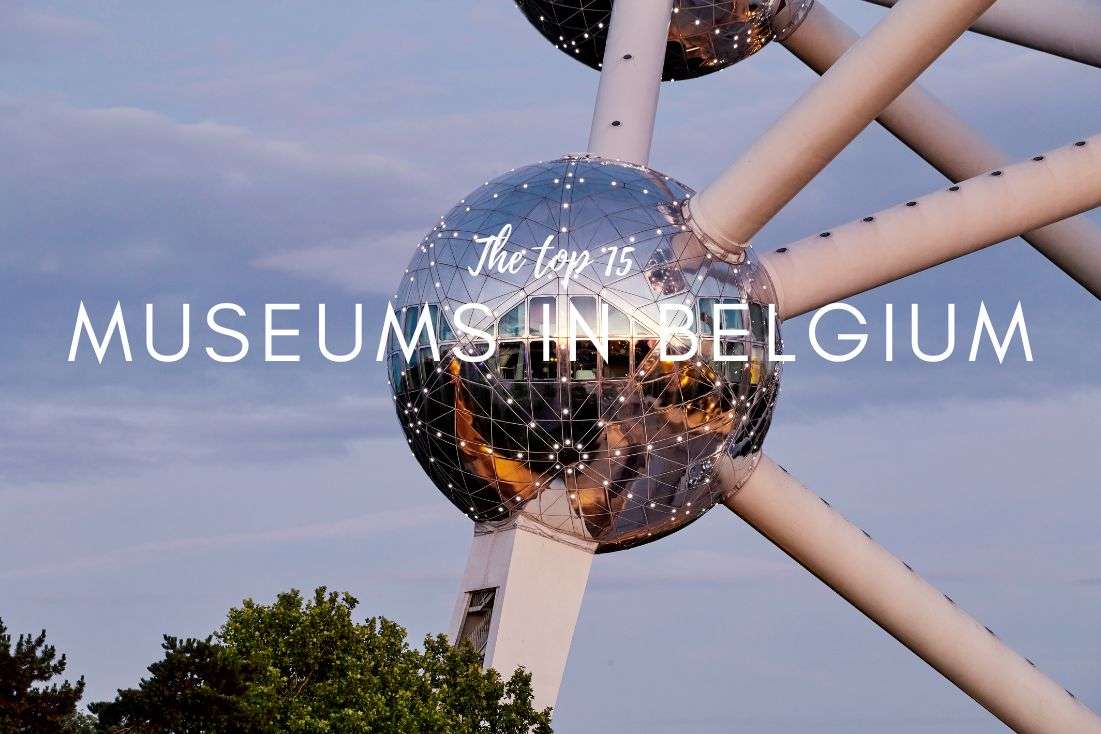
Quick list: The best museums in Belgium with descriptions (ranked)
1. Bruges Beer Experience: A must-do museum in Belgium for EVERYONE
2. Mini-Europe in Brusselss: the “tiniest” fun museum in Belgium
3. Parlamentarium in Brussels: a museum that’ll spark your love for the EU
4. Autoworld in Brussels: the biggest car museum I’ve ever seen
6. De Halve Maan Brewery in Bruges: check out the unique beer pipline!
7. Train World In Brussels: step inside an original Orient Express car!
8. Choco Story Museum in Brussels: is it better than the one in Bruges?
9. The House of European History in Brussels: A museum inside the European Partliament
10. Photography Museum in Charleroi: the best photography museum in Europe
11. Comics Art Museum in Brussels: A kid-friendly museum in Brussels that’s also fun for adults
12. The Atomium in Brussels: go inside one of Europe’s most famous modern structures
13. Bruges Art Museums: The quieter side of Belgian art, with more history than crowds
14. Musée Magritte Museum in Brussels: the best place to get “surreal” with Belgian art
15. The Belfries in Bruges and Ghent: two iconic towers with museums inside
How to plan a visit to the best museums in Belgium: notes before you go
Some of my favorite museums in the world are in Belgium. Heck, I was almost ready to breeze through the capital in a day until I realized that the best museums in Brussels will keep me entertained for at least a long weekend! But it didn’t stop there, and I found some of Belgium’s best museums in cities like Bruges, Ghent, and Charleroi.
Why are Belgium’s museums so good? Honestly, you can tell Belgians put so much thought and money into making their museums interactive, fun and inspiring. It just SHOWS.
I’m a museum geek, so I happily visited no less than 20 museums on a single trip to Belgium—I kid you not. But I’m not about to share every single place I visited over all my visits—I only recommend those that really deserve your attention. We don’t have low standards here at Next Level of Travel. Only the best of the best is good enough!
In this article, I describe my experience at 15 top museums in Brussels and beyond that I think are worth your time, from incredible beer museums and art museums in Belgium to funky comics museums, EU museums, and chocolate museums. There’s something for everyone on this list.
All you need to do is use my museum obsession to plan your own trip to Belgium and I guarantee you’ll have a fantastic trip.

Quick list: The best museums in Belgium with descriptions (ranked)
-
Bruges Beer Experience (Bruges)
A surprisingly fun and interactive museum about Belgium’s beer culture—great for everyone, even non-drinkers. -
Mini-Europe (Brussels)
An outdoor park with miniature versions of Europe’s landmarks, from the Eiffel Tower to Dover Castle. -
Parlamentarium (Brussels)
The European Parliament’s visitor center offers free, high-quality exhibits on the EU's history, politics, and impact. -
Autoworld (Brussels)
A massive car museum inside a palace, with everything from vintage Belgian cars to American classics and comics legends. -
Royal Museum of the Armed Forces and Military History (Brussels)
One of Europe’s biggest military museums. Includes access to the Triumphal Arch. -
De Halve Maan Brewery (Bruges)
A historic city-center brewery with a beer pipeline, rooftop views, and the only place you can try the unfiltered Brugse Zot beer. -
Train World (Brussels)
Belgium’s national railway museum, packed with hands-on exhibits and a real Orient Express carriage. -
Choco Story Museum (Brussels)
The best chocolate museum in Belgium—learn about cacao history, taste pralines, and see some wacky chocolate sculptures. -
House of European History (Brussels)
A free museum walking you through European history from ancient times to today. Unexpectedly engaging. -
Photography Museum (Charleroi)
Europe’s top photography museum with works by legends like Cartier-Bresson, Man Ray, and August Sander. Housed in a stylish mix of old convent and modern art gallery. -
Comics Art Museum (Brussels)
Great for families and fans of the art form, with behind-the-scenes displays on comic-making. -
The Atomium (Brussels)
An iconic Brussels landmark. Inside the giant steel spheres are exhibitions, light shows, and a panoramic view from the top. -
Bruges Art Museums
A trio of excellent museums—Groeninge (Flemish art), Gruuthuse (city history), and Sint-Janshospitaal (medieval hospital + art)—all within a few steps of each other.
-
Musée Magritte Museum (Brussels)
The world’s largest Magritte collection—surreal, stylish, and best visited with the audio guide. -
Belfries of Bruges and Ghent
Historic towers with small but worthwhile exhibits inside—and some of the best city views in Belgium.
Here are all my tips for the best museums in Belgium, some of them famous, some of them hidden gems:
Sometimes, all you need to do is take the first step... I've filtered out the best hotels in Brussels for you
Save it for yourself to come back to later, or share with your friends on social media!
I've already planned your ititnerary for the trip, complete with my travel tips.
1. Bruges Beer Experience: A must-do museum in Belgium for EVERYONE
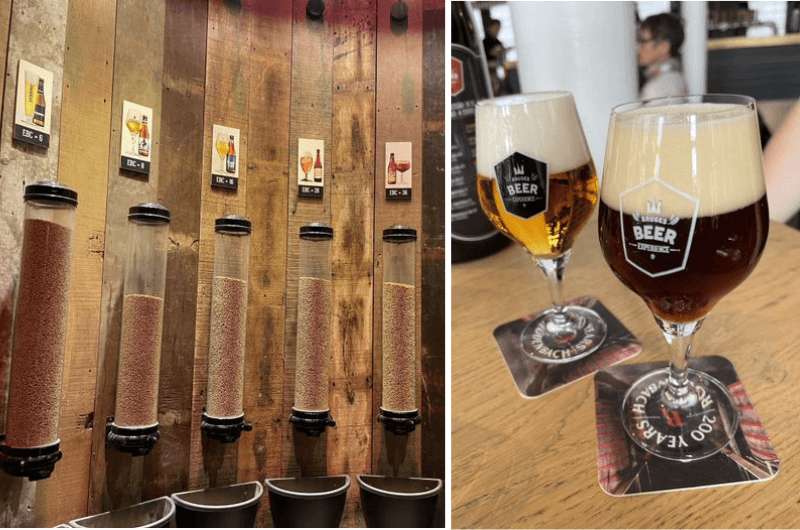
Left: Smell some hops and become a beer expert! Right: Taste some beer and become a beer expert! @ Bruges Beer Experience
There’s no more fitting way way to start a best museums in Belgium list than with a beer museum! It was really that good!
The Bruges Beer Experience was fabulously interactive and fun, and I urge everyone—non-beer-drinkers and kids included—to visit. We got a tablet and headphones and were on our way. I loved that you can go at your own speed, no need to shuffle around in a group. The exhibits do an excellent job telling you the story of beer, its history, production, and how it was perceived in different countries.
There is even a kid’s version of the tour available.
My fellow Czechs could learn a thing or two at the Beer Experience—like that our beloved lager is actually the last beer created and as such is a pretty lame drink.
The first beer that comes out is, in fact, much fruitier. And then there are a myriad other different types and tastes that are superb quality, all trumping the poor lager. Something that a typical Czech beer drinker wouldn’t even dream of being true.
The existence of this sheer array of beers gives way to entirely different beer culture in Belgium so much more. The beer in Belgium is what wine is in other countries—a high-end beverage that gets paired with chocolates, cheeses and Michelin restaurant dishes! Now that’s my type of dining!

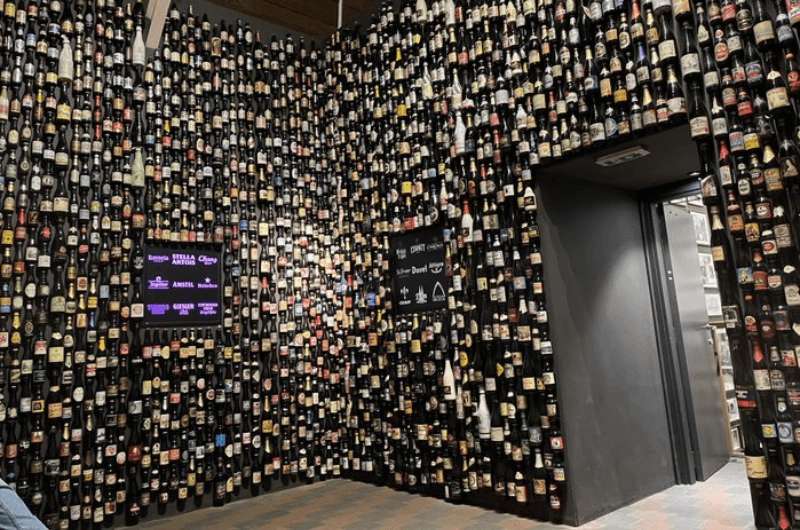
My idea of interior decorating
At the end of the tour, you get a tasting of 3 (strong!) beers, which, if you hadn’t been in a good mood before, will solidify your good experience of the Beer Experience. It’ll all take 3 hours.
Dogs are allowed. Giraffes are not. (I stole that from the Beer Experience website, because it made me lol!)
Pro tip: You can visit the tasting room even if you don’t take the tour.
Visitor information
- Bruges Beer Experience, Breidelstraat 3, Bruges
- Open daily 10 am–6 pm (last entry 1 hour before closing). The bar closes at 6:30 pm.
- Tickets cost €14 without a beer tasting (but who would want that?!), €20 with a tasting.
2. Mini-Europe in Brusselss: the “tiniest” fun museum in Belgium
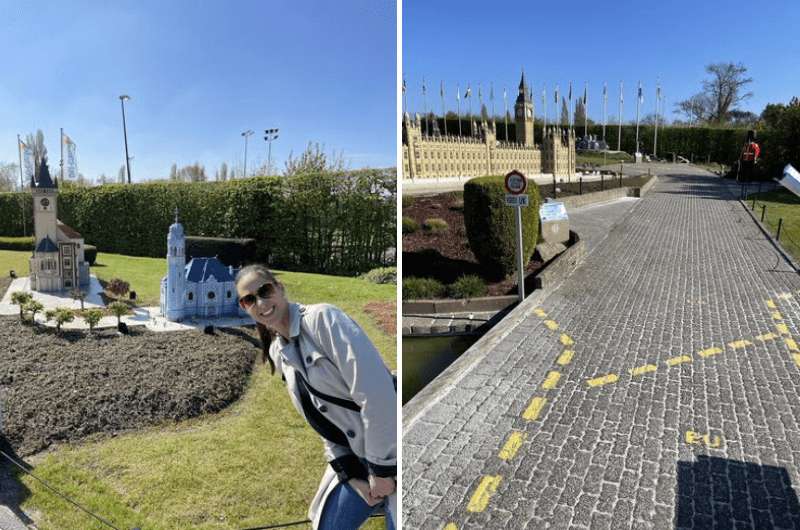
Left: I was actually surprised how much Karin enjoyed Mini-Europe. Right: You are leaving the EU.
One of the most entertaining places in Brussels is Mini-Europe, which is just what you think it is—a small Europe. I count it as a museum in Belgium because you can walk through all the European countries in a matter of hours. Thanks to this I realized that I have yet to visit so many amazing cities in Europe! So little time, so much traveling to do.
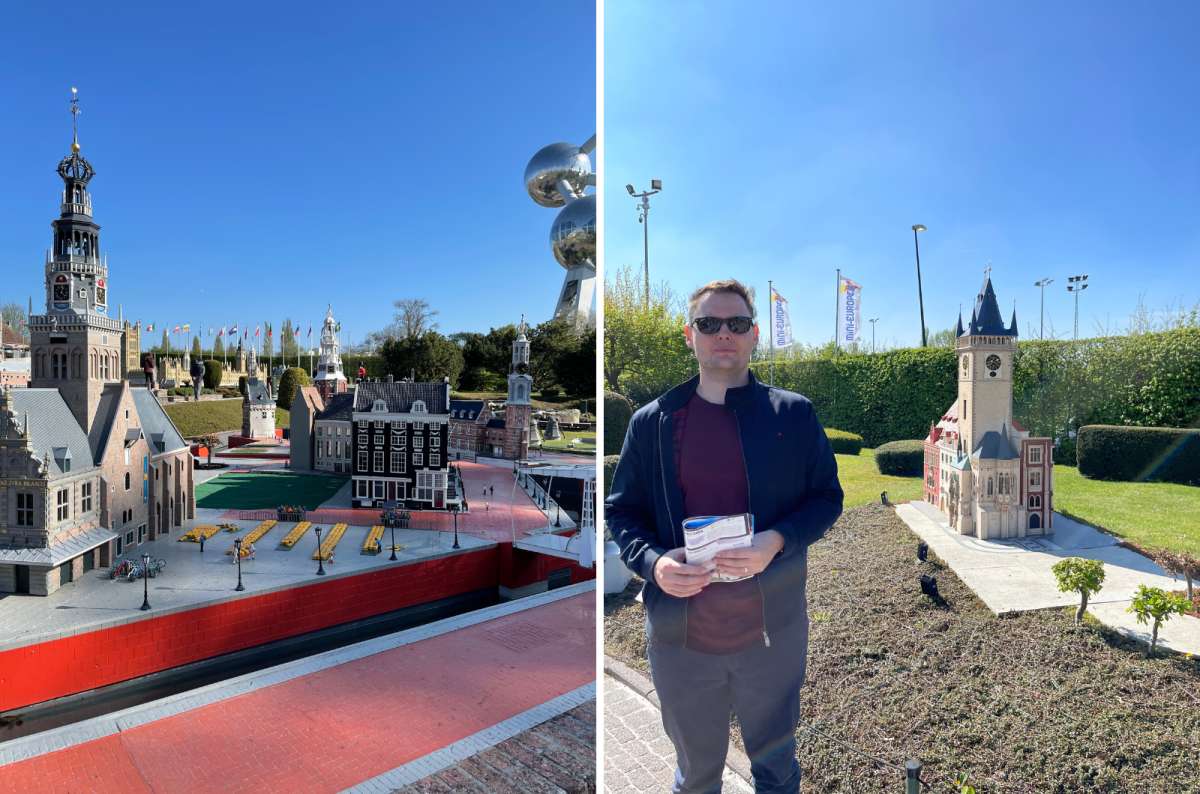
The whole of Europe in one place @ Mini-Europe
Mini-Europe is a place where you can see miniature models of important buildings from around Europe. than others. My favorites were Nyhavn (Denmark), Dinant and the Grand Place (Belgium) and Dover Castle (UK). Speaking of which, yes, the UK is still represented, but there is now a border showing that you are leaving the EU. Made me chuckle.
The models aren’t even that small, with some towers and castles easily reaching the height of an adult, and tall structures like the Eiffel Tower being way higher than that still. Add 9000 little people to that. Those are, in fact, little.

The Atomium will make an appearance in a lot of your Mini-Europe photos
We visited without kids and spent 4 hours there.
Fun fact: The models in Mini Europe are works of art. They are incredibly expensive to build—something like €70k+ per structure! Just Brussels Square came to a total of €350k. When the tower of city hall had to be repaired after a hurricane a while back; just that cost €50k.
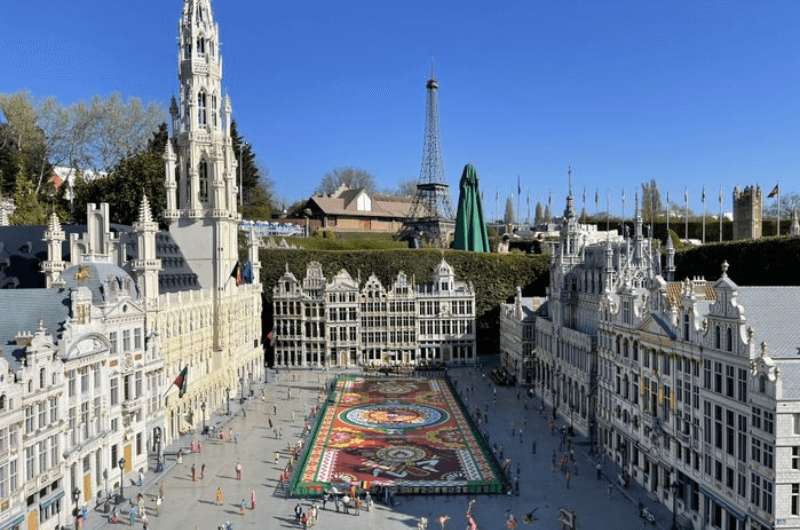
This is Brussels’ Grand Place, miniature version. Just wow!
Another fun activity you can take part in is trying to get the perfect Mini-Europe pic with the Atomium in the background. We certainly did. It’s even bigger now that you compare it to itty bitty Paris or Prague.
Visitor information
-
Mini-Europe, Av. du Football 1, Brussels
-
Open daily 9:30 am–6 pm (until 7 pm in July and August)
-
Tickets cost €25.50. The combination ticket with Atomium costs €32.60
3. Parlamentarium in Brussels: a museum that’ll spark your love for the EU
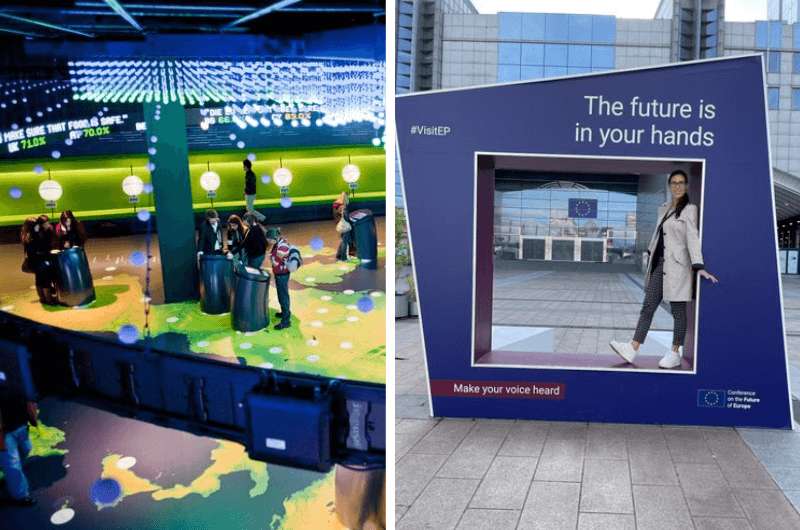
The visitors’ center at the European Parliament is called Parlamentarium. We loved it!
Visiting the visitors' center of the European Parliament made me giddy like a kid in a candy shop. You can’t not visit an EU museum in Belgium!
It’s just special. I mean, I loved the EU before this, but after this visit, I am head over heels.
As can be expected, in this top museum in Brussels, you learn about the history and creation of the European Unionthrough a myriad of interesting and interactive exhibits. Plus, you get to keep the pen they give you at the entrance. Free souvenir!
Pro tip for your viait: Don’t spend 10 minutes looking for the ticket desk like we did. There is none. The Parlamentarium is free, though you do have to book your visit online—it’s easy.
Oh, and the staff are lovely and the multimedia guides are available in all EU languages (including sign languages). Now that’s welcoming.
Set aside 1.5 hrs to see it all. I dare you not to like it there.
Visitor information
-
Parlamentarium, Pl. du Luxembourg 100, Brussels
-
Open daily: Mondays 1 pm–6 pm, Tuesday to Friday 9 am–6 pm, weekends 10 am–6 pm
-
Free entry, but you need to book a time online beforehand
4. Autoworld in Brussels: the biggest car museum I’ve ever seen

Me with Tintin’s car and Karin with an oldie but goodie BMW 507
Autoworld is one of the largest car museums I’ve ever been to. And one of the best. This place can’t not make my list of best museums in Belgium, and it’s another one that’s not just for enthusiast—even if you’re not that into cars, you’ll enjoy yourself here.
There are various zones in Autoworld, each focused on a specific topic or country. There is the sports & competition zone with old and new racing cars, the USA zone getting you a feel for the American dream, the comic section, which is just pure fun, and then the biggest one, the Belgian zone, dedicated to Belgium’s automobile heritage (didn’t know there is one, did you?).
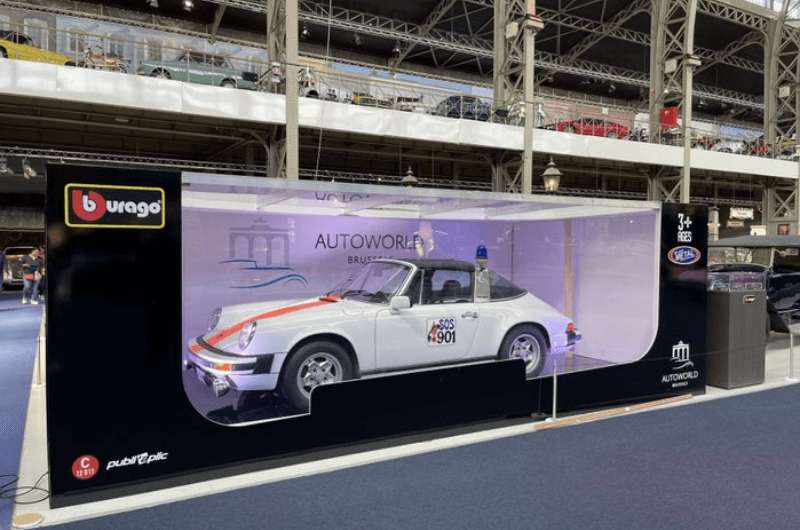
Gotta love a museum with a sense of humor
Autoworld houses some great pieces for the typical car nerd that resides in almost every guy and some girls, like the Corvette C2, 1960 BMW 700 or my personal childhood favorite, the Honda NSX. Known to you Americans as the Acura NSX.
You can look around in 1–2 hours depending how much of a car fanatic you are.
Visitor information
-
Autoworld, Parc du Cinquantenaire, Brussels
-
Open daily 10 am–5 pm (6 pm on weekends)
-
Tickets cost €16
5. Royal Museum of the Armed Forces and Military History in Brussels: the best history museum I’ve ever been to
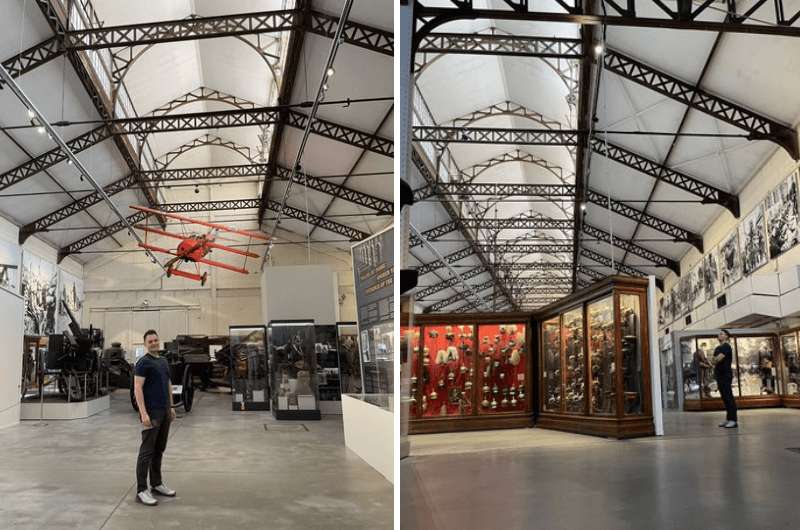
Big smiles geeking out with the Red Baron plane and trying to see it all @ Royal Museum of the Armed Forces and Military History
This was my jam! Karin… not so much. Had I been alone I would’ve spent all day here, no exaggeration. It’s one of the biggest museums I’ve visited in my life, not to mention one of the most memorable museums in Brussels.
The Museum of Armed Forces does an excellent job providing context and perspective to international events such as WWI and WWII. There’s a whole hangar dedicated to each of these wars and just learning about the points of view of each country (even African ones) was a real eye opener.
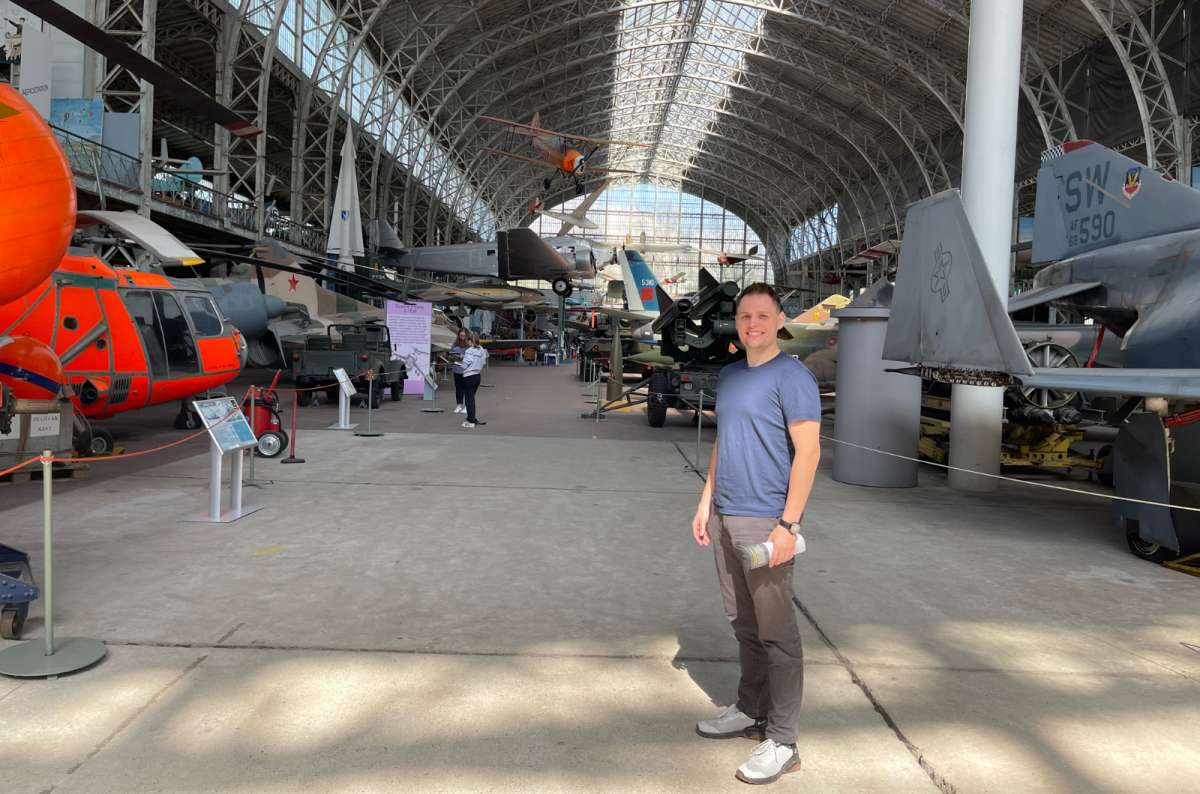
Beaming with excitement @ Royal Museum of the Armed Forces and Military History
You’ll take a walk through history starting from the Middle Ages until present day, looking at everything from arms and armor to tanks and airplanes. The latter in the connected Aviation Gallery. There are 11 sections in the museum.
Everything is ordered chronologically so you can pick and choose and skip around if you’ve got a particular interest in some areas and not so much in others.
I’d say put aside a minimum of 3 hours for this museum.
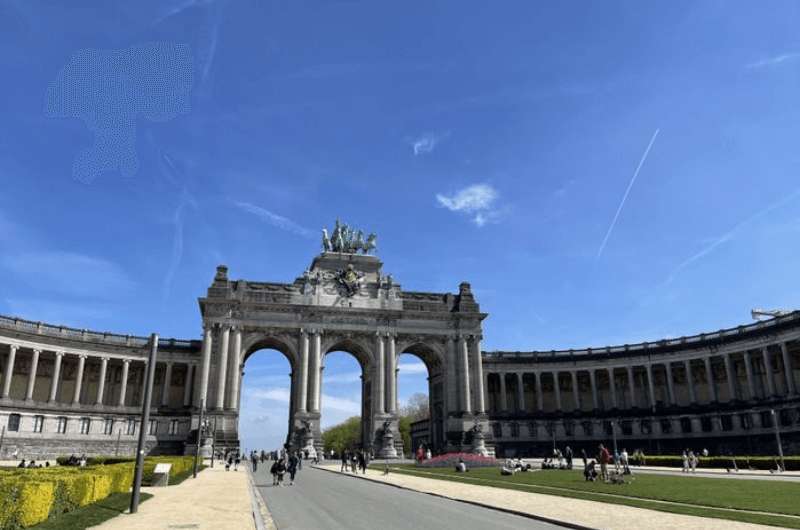
The views from the top of the Triumphal Arch were epic!
Pro tip: The Royal Museum of Armed Forces is located in the pretty Parc du Cinquantenaire, s to the left of the Triumphal Arch. With a ticket to the Royal Museum of Armed Forces, you can climb up the arch and get an epic view of Brussels from there.
Visitor information
-
Royal Museum of the Armed Forces and Military History, Parc du Cinquantenaire, Brussels
-
Open daily except Mondays 9 am–5 pm (last entry at 4 pm)
-
Tickets cost €11 and can only be bought using a credit/debit card at the entrance
6. De Halve Maan Brewery in Bruges: check out the unique beer pipline!
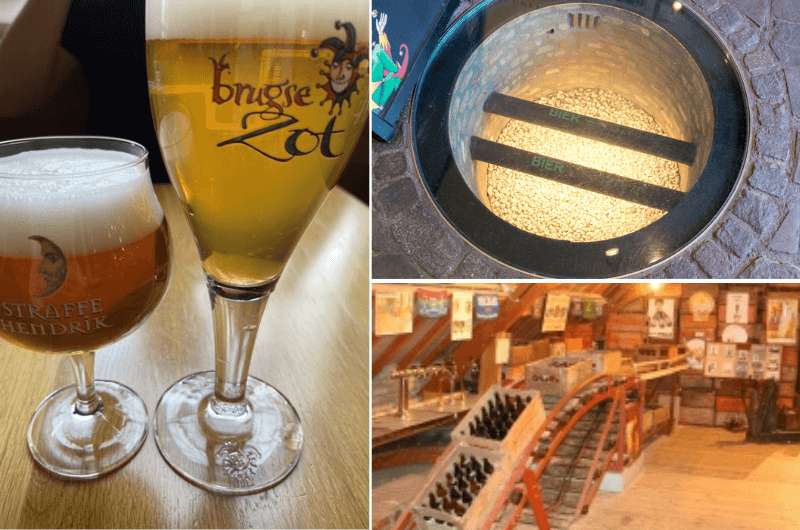
The unfiltered Brugse Zot, the beer pipe and part of the brewery tour
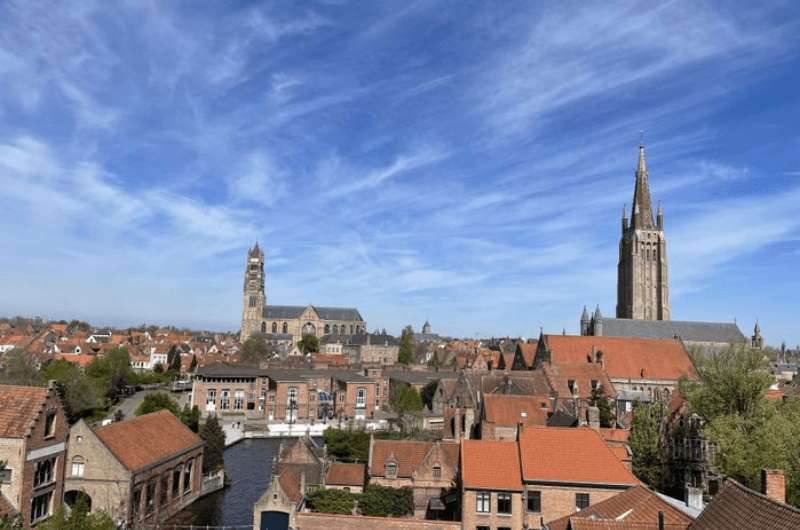
The views from the brewery rooftop. That’s the Bruges‘ Belfry on the left.
De Halve Maan (“The Half Moon”) prides itself in being the only brewery that stayed in central Bruges, unlike all the other breweries that moved outside of the city to bigger and more modern buildings. So, when you visit, you’re able to see the narrow winding staircases and truly feel like you’re getting a real sense of their long history (established in 1564!).
When I visited this great museum in Belgium, I took the 45-minute tour. I learned about the fascinating history of this family business, and even saw the one-of-a-kind, 3.2 km (2 miles) beer pipeline connecting the brewery and the beer bottling plant.
The guide was entertaining and informative, and I very much enjoyed the entire tour. It ends on the brewery rooftop where you get not only a free beer, but a fantastic view of Bruges.

Fun fact: The unfiltered Brugse Zot can only be bought at De Halve Maan brewery. It was fab.
Visitor information
-
De Halve Maan Brewery, Walplein 26, Bruges
-
Open daily 11 am–5 pm, Saturdays 10 am–6 pm. Tours in English run 4x a day
-
Tickets cost €16 for the standard 45-minute tour, €26 with an additional beer tasting at the end. Book online in advance to secure a spot.
7. Train World In Brussels: step inside an original Orient Express car!
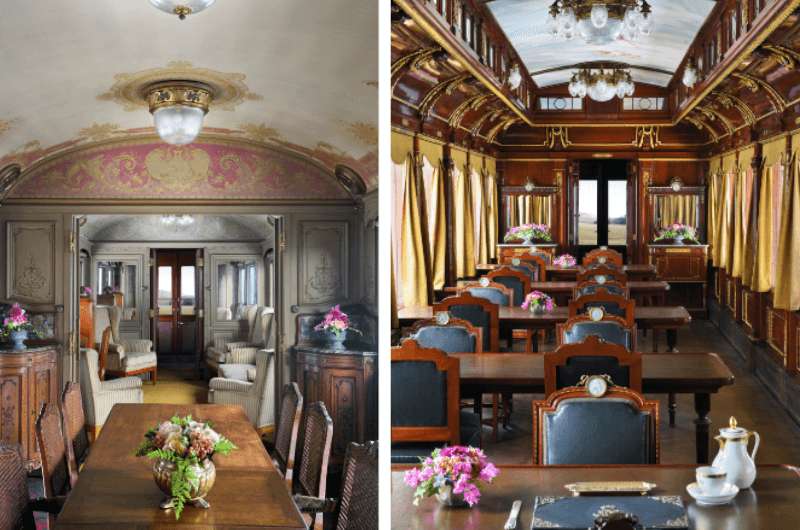
How the fancy people used to travel @ Train World
Train World is the official museum of the National Railway Company of Belgium and you get what you think you’ll get, but cooler—I’m not just about to name a random train museum on my top picks for Belgium’s top museums. In a country where even I think traveling by train is the way to go, it’s a must-visit museum for adults and kids alike. (More travel tips for Belgium in a separate article.)
There are more than 20 locomotives from the first steam ones to the high-speed types of present day that you can not only see, but also climb into and look around in, pretending to be the conductor. Now that’s fun even if you’re not a kid. Come on, choo choo!
You’ll love the restored original of an Orient Express carriage. Yes, you can go inside!
Two hours should be enough for your visit to Tran World in Brussels. Get your tickets in advance. There are also guided tours available.
Visitor information
- Train World, Pl. Princesse Elisabeth 5, 1030 Schaerbeek (Brussels)
- Open daily except for Monday 10 am–5 pm (last entry at 3:30 pm)
- Tickets cost €15 and are time-slotted. Get them in advance to jump in front of the line.
8. Choco Story Museum in Brussels: is it better than the one in Bruges?
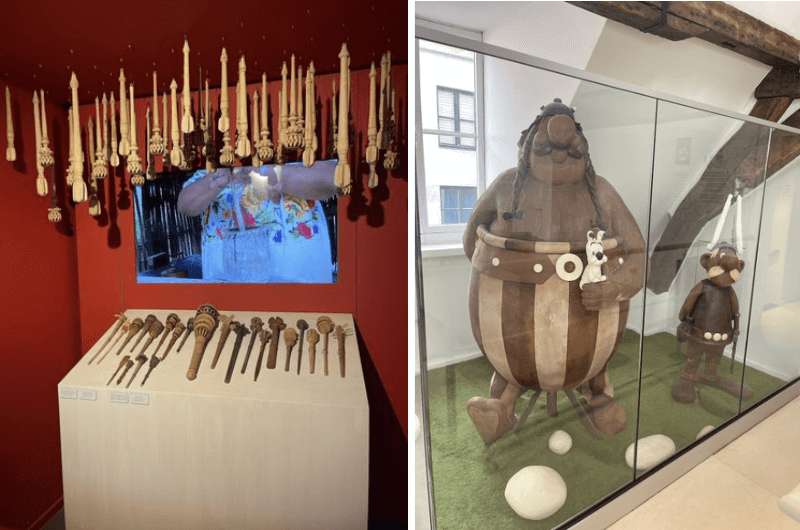
You learn some, you laugh some. Good times at the Choco Story Museum
The Choco Story Museum in Brussels is by far the best chocolate museum I’ve ever been to, and I’ve been to about 10 all over the world. It’s not just one of the best museums in Belgium, it’s one of my favorite in the world—I’m really trying to find the best places for you guys. The difference in budget is really visible at this museum compared to the ones in, say, South America.
Grab the audio guide to get the most out of your visit to this great museum in Brussels. You learn about everything from harvest and production to the different types of cacao and their health benefits. You hear about the history all the way back from the Mayas up to present day.
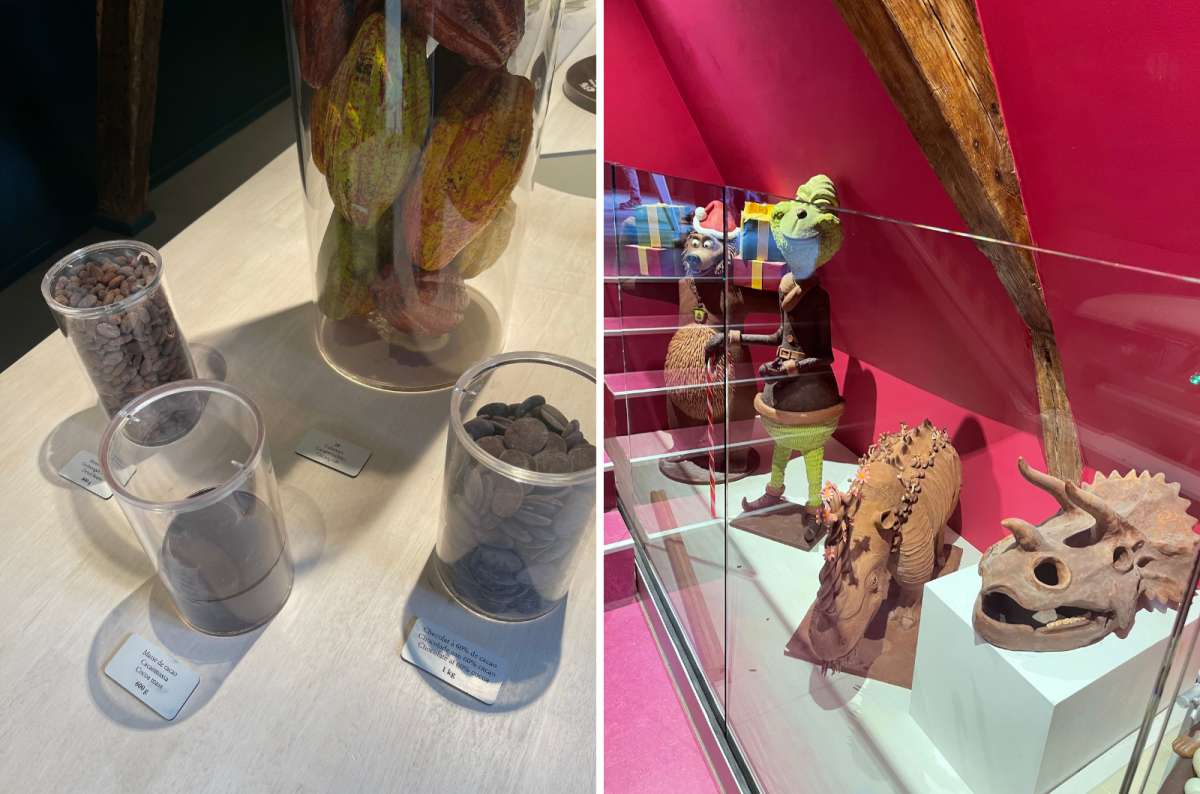
Choco Story is no joke
Highlights of my Choco Story tour in Brussels:
- the praline tasting at the end, obviously
- a big chocolate statue of Obelix
- the chocolate version of the squirrel from Ice Age
- a chocolate Manneken Pis?! (one of the top things to see in Brussels, though I find the chocolate one way more entertaining)
- a lot of fun and weird trivia, like the fact that when a French duchess had a black baby back in the day, it was said it must’ve been because she ate a lot of chocolate. Because the alternative was just too naughty.
Pro tip: Buy your tickets ahead of time. You reserve a time slot and then just breeze past the long line to the reception where you pick up your audio guide.
The tasty excursion through the Choco Story Museum will take you 1.5 hours.
Visitor information
-
Choco Story Museum, Rue de l’Etuve 41, Brussels
-
Open daily 10 am–6 pm (last ticket slot at 5 pm)
-
Tickets cost €13
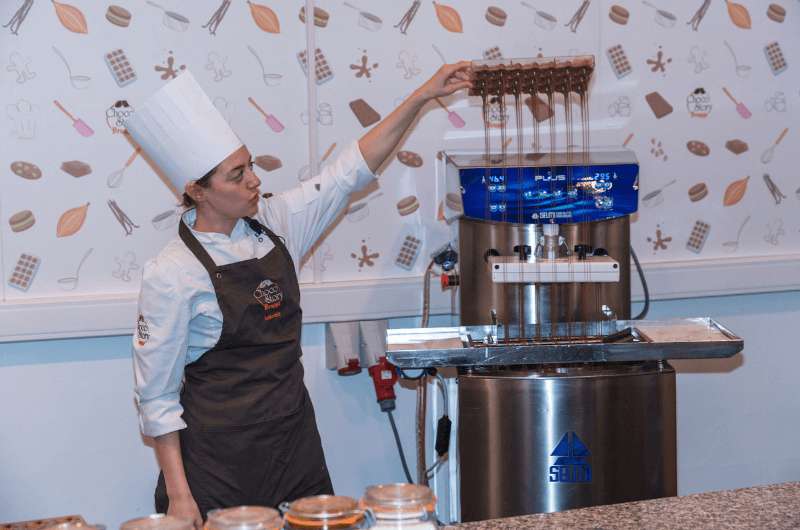
You pour the chocolate here and then press this button here…
Is the Choco Story in Bruges worth it?
Yes, there’s a Choco Story in Bruges, too. It is similarly shiny and new as the one in Brussels, but it isn’t as hands-on, so I rate it lower than the one in the capital.
The audio guide lets you participate in several games in Choco Story, and there is a demonstration room at the very end where you can taste unlimited chocolate.
There’s a one-way path through the museum that’ll take you about 1.5 hours to complete.
Visitor information
-
Choco Story Brugge, Wijnzakstraat 2, Bruges
-
Open daily 10 am–6 pm (last ticket sales at 4 pm)
-
Tickets cost €13
9. The House of European History in Brussels: A museum inside the European Partliament

Europe in Ruins exhibition @ House of European History
You are now entering the European Parliament—a fantastic museum in Belgium. And as a huge fan of democracy and the EU, I’m here for it.
There’s so much to discover at this well-curated museum. It leads you through the history of Europe from ancient times to today.
It might sound semi-boring on paper, but the way they showcase the information really sucks you in and brings you through the times. It’s interactive, it’s modern, it’s in your face with great use of space, things like actual cars and furniture, and a huge art installation spanning several floors.
You will be guided through the 4 floors of the House of European History with the help of a complimentary iPad (I mean for use in the museum, not actually complimentary as in a gift).
Visitor information
-
House of European History, Rue Belliard / Belliardstraat 135, Brussels
-
Open Mondays 1 pm–6 pm, Tuesdays to Fridays 9 am–6 pm, weekends 10 am–6 pm
-
Tickets cost €0. Yep, it’s free.
10. Photography Museum in Charleroi: the best photography museum in Europe
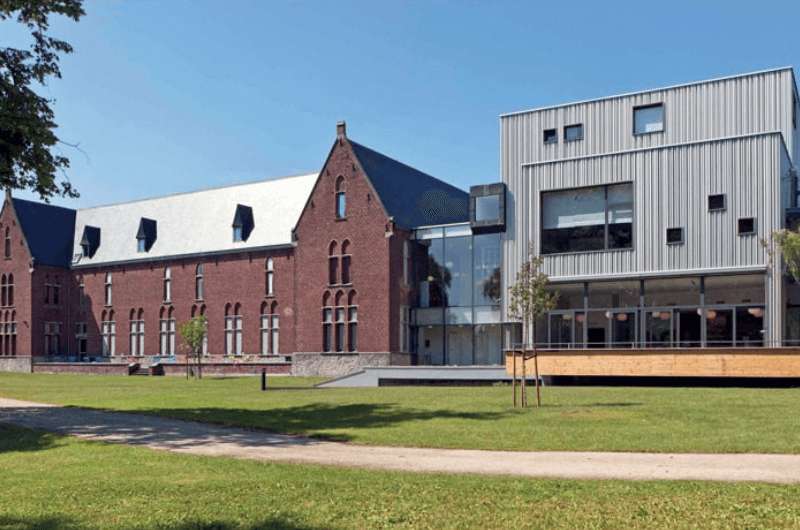
Mixing the old with the new @ Photography Museum, Contemporary Art Center of the French Community
Charleroi made my list of the top places to visit in Belgium even though it has also earned the title of the ugliest city in the country. One of the reasons it’s on there is because art aficionados agree that Charleroi’s Photography Museum is the best in Europe.
You’ll see photographs from the beginning of time... well, at least since the beginning of photography in the 19th century, up until the present day. All the greats are represented. Get on a guided tour if you want to hear the stories behind the photographs.
There’s also an educational exhibit that teaches you about the science of cameras and lenses, including a showcase of the evolution of cameras. Lots of antique pieces on display.
Big names you’ll find in the collection in Charleroi (permanent or rotating):
-
Robert Doisneau—Brilliant street photography and that kiss photo in Paris.
-
Henri Cartier-Bresson—The godfather of candid photography and the “decisive moment” master.
-
Man Ray—You don’t go to Belgium expecting this kind of avant-garde weirdness, but here it is.
-
August Sander—The German photographer who took straight-on portraits of everyday people to show what society really looked like.
-
Belgian photographers, like Stephan Vanfleteren and Dirk Braeckman, who both know how to make bleakness look stunning.
The Photography Museum, Contemporary Art Center of the French Community is housedin a renovated convent building, with a contemporary wing added to the side of it. Even just this contrast of the old and new architecture is worth seeing, though the exhibitions inside (and outside) make it a must-see art museum in Belgium on any art literate tourist’s visit.
The museum is huge, so you should count on spending 3 hours there, more if you’re a dedicated photography fan. You can take a break in the on-site café.
Visitor information
-
Photography Museum, Contemporary Art Center of the French Community, Av. Paul Pastur 11, Charleroi
-
Tuesday-–Friday 9am–5pm, weekends 10 am–6 pm, closed Mondays
-
Tickets cost €8
11. Comics Art Museum in Brussels: A kid-friendly museum in Brussels that’s also fun for adults
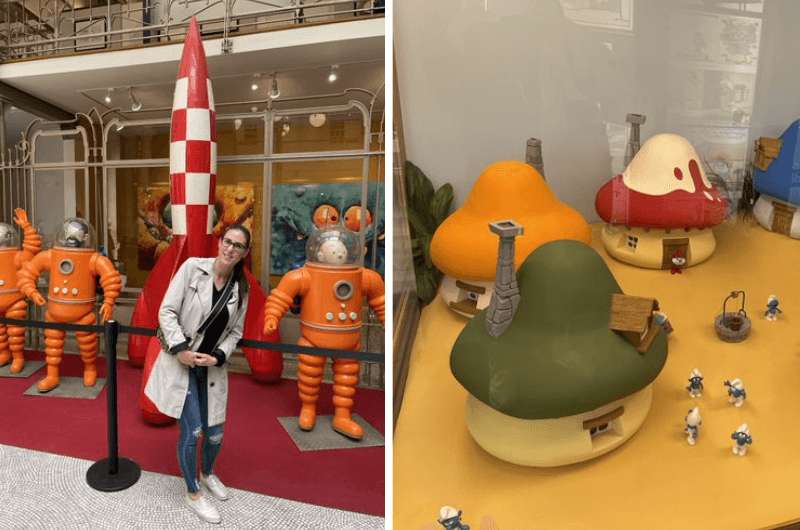
You can’t deny the Comics Art Museum is cute
The Comics Art Museum (aka the Belgian Comic Strip Center) is one of the popular museums in Brussels that had immense potential and fell a tiny bit flat for me. It’s not that the Comics Art Museum is bad, it’s just that the other unique and famous museums in Belgium are so good, that being just good is suddenly not enough. They could’ve taken the comic theme and ran with it, and instead they just jogged.
My favorite part? You'll see how comics are made—from early pencil sketches to inking, layout, and publication.And, of course, the Smurfs zone.
Did you know the Smurfs were Belgian? They are! And so is Lucky Luke, and of course, Tintin. You’ll know the teenager and his dog are Belgian the moment you step on the plane. Comics are a huge deal in Belgium, and you’ll be made aware of this pride often, and not just at this museum.
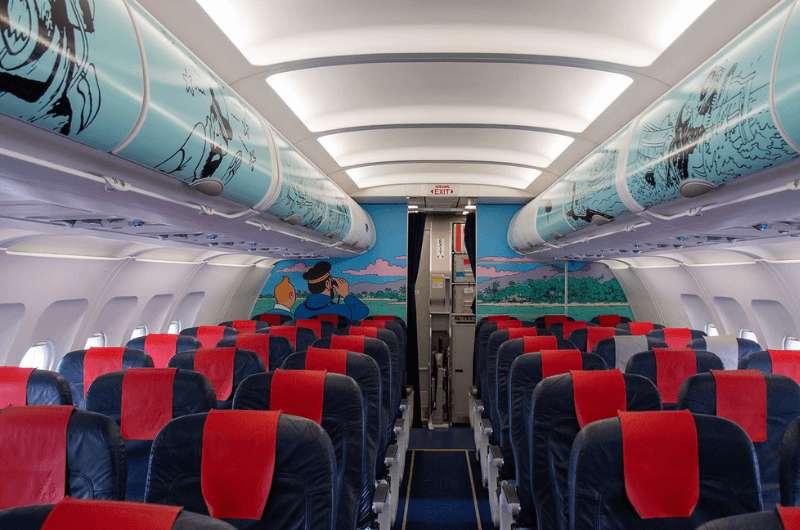
There’s no doubt which airline you’re on. Image source: https://www.brusselsairlines.com/
You can be in and out in about 1.5 hours.
Visitor information
-
The Comics Art Museum, Rue des Sables 20
-
Open Tuesday to Sunday 10 am–6 pm (last admission at 5 pm). Open daily during July and August.
-
Tickets cost €14
12. The Atomium in Brussels: go inside one of Europe’s most famous modern structures
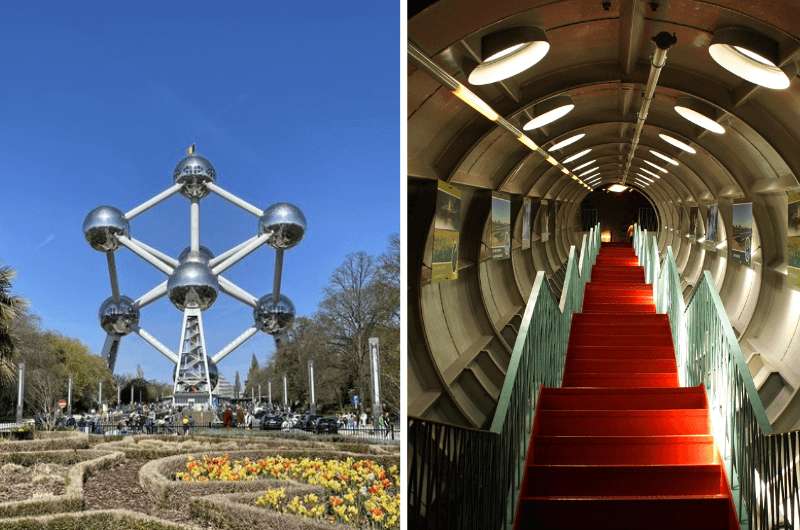
The escalator even has a light show going on. It’s like a trip to Space Mountain!
The Atomium is one of Belgium’s famous landmarks, but did you know it’s also a museum in Brussels?
The famous giant steel atom was originally constructed as the main pavilion for the 1958 Brussels World's Fair.
Nowadays, you can go inside 5 of the 8 spheres and the concrete building at the base. There are museum exhibits, a restaurant, a gift shop and a light & sound display. The very top orb is a viewing platform. It is accessed by an elevator and is 92 m (300 ft) above ground.
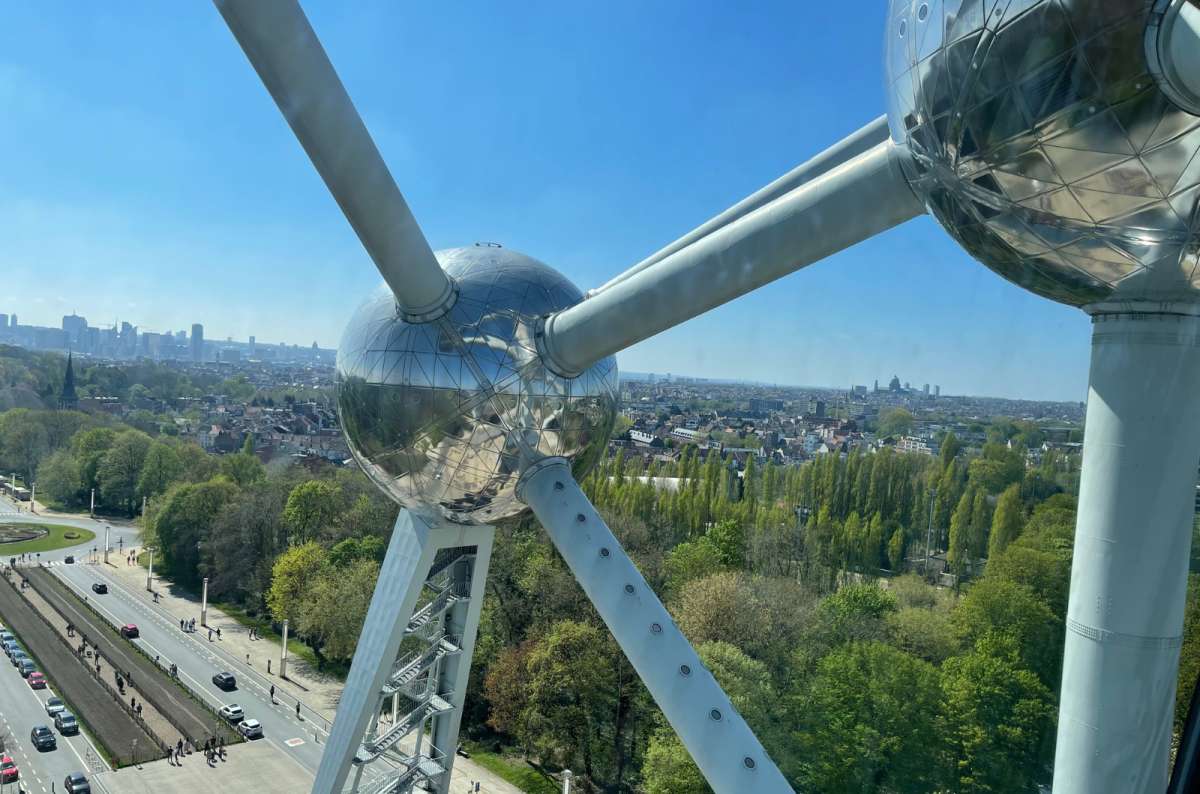
The Atomium in detail
It’s all very spaceship-like, not a typical museum experience. There are escalators and red staircases that take you through the steel tubes between the balls, it’s dark with lights flashing around… all that was missing was Chewbacca walking by. Or maybe complimentary light sabers.
Visitor information
-
Atomium, Pl. de l'Atomium 1, Brussels
-
Open daily 10 am–6 pm (last entry at 5:30 pm)
-
Tickets cost €16 and can be bought online to avoid the long lines. There is a small extra fee when buying online. The combination ticket with Mini Europe costs €32.60
13. Bruges Art Museums: The quieter side of Belgian art, with more history than crowds
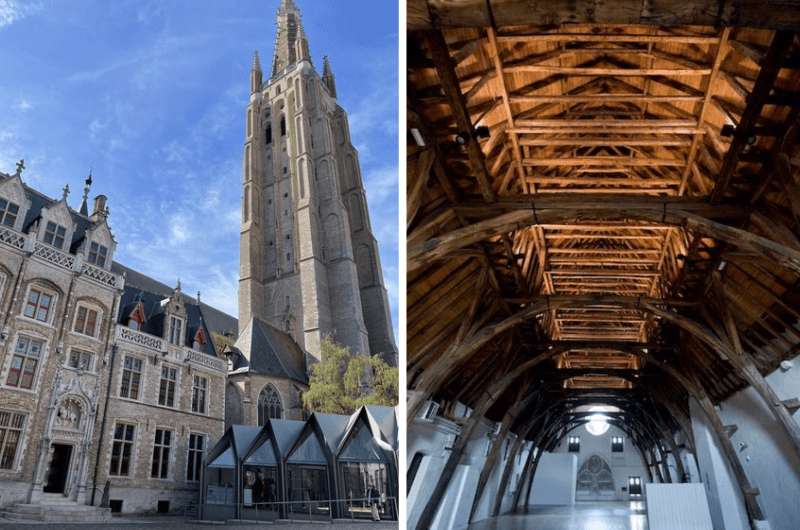
Left: Gruuthusemuseum exterior (that tall tower is not it, it’s the tower of the Church of Our Lady Bruges). Right: the oak ceiling at Sint-Janshospitaal Museum.
There are three art museums in Bruges basically next to each other where you can see everything from masterpieces to old doctors’ tools.
Groeninge Museum, one of the best Belgian art museums (without the crowds)
The Groeninge Museum takes you through six centuries of Belgian art. You start with the Flemish primitives and end with modern art by René Magritte, Roger Raveel and Raoul De Keyser.
Visitor information
-
Groeninge Museum, Dijver 12, Bruges
-
Closed Mondays. Otherwise open daily 9:30 am–5 pm
-
Tickets cost €14
Gruuthusemuseum isn’t just about art—it’s about how Bruges lived
Gruuthuse is the restored palace of the lords of Bruges. The Gruuthusemuseum tells the story of 500 years of the city’s history through objects from tapestries and stained-glass windows to lace and porcelain. They must be doing something right, because the Gruuthusemuseum was awarded Europe’s Most Welcoming Museum in 2021.
Visitor information
-
Gruuthusemuseum, Dijver 17, Bruges
-
Closed Mondays. Otherwise open daily 9:30 am–5 pm
-
Tickets cost €14
St. John’s Hospital—one of the oldest art museums in Belgium (and also a medieval hospital)
Sint-Janshospitaal (St. John’s Hospital) is one of the oldest preserved hospitals in Europe, so you can not only admire artwork by Flemish artist Hans Memling at the art museum, but also see what it was like in a hospital centuries ago.
Check out the old hospital wards and look up at the oak ceiling of the Middle Ward.
Fun fact: You can see and learn about the peculiar back door of the hospital on the boat tour of the canals.
Visitor information
-
Sint-Janshospitaal Museum, Mariastraat 38, Bruges
-
Closed Mondays. Otherwise open daily 9:30 am–5 pm
-
Tickets cost €12
14. Musée Magritte Museum in Brussels: the best place to get “surreal” with Belgian art
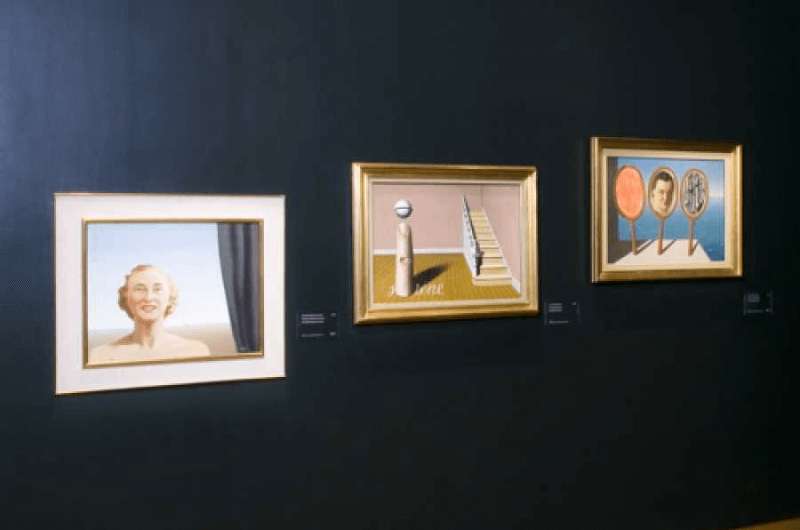
Some of the paintings @ Musée Magritte Museum
The Musée Magritte Museum is a an art museum in Brussels with the largest collection of the surrealist’s works in the world.
Who was René Magritte?
René Magritte was a Belgian surrealist who painted ordinary things—pipes, bowler hats, apples—and made them weird enough to get noticed. For example, the famous picture of a pipe that says, “This is not a pipe.”
The only annoying part about this Belgian art museum is that there are no English signs, so an audio guide is a must. So even though there are over 200 pieces on display, including rare photographs and letters, without the audio guide you have no context.
That said, Magritte’s artwork is super interesting to look at, so you can do just that and still be satisfied with your museum visit.
Pro tip: Take care when you’re planning your visit to this art museum—there are two places in Brussels under a similar name. The other one, the René Magritte Museum is his former residence and is also good, but not a must-visit (details in my best things to do in Brussels article).
Visitor information
-
Musée Magritte Museum, Koningsplein 1, Brussels
-
Open Tuesday to Friday 10 am–5 pm, Saturday and Sunday 11 am–6 pm
-
Tickets cost €10, plus €4 for an audio guide (they even have special ones for kids)
15. The Belfries in Bruges and Ghent: two iconic towers with museums inside
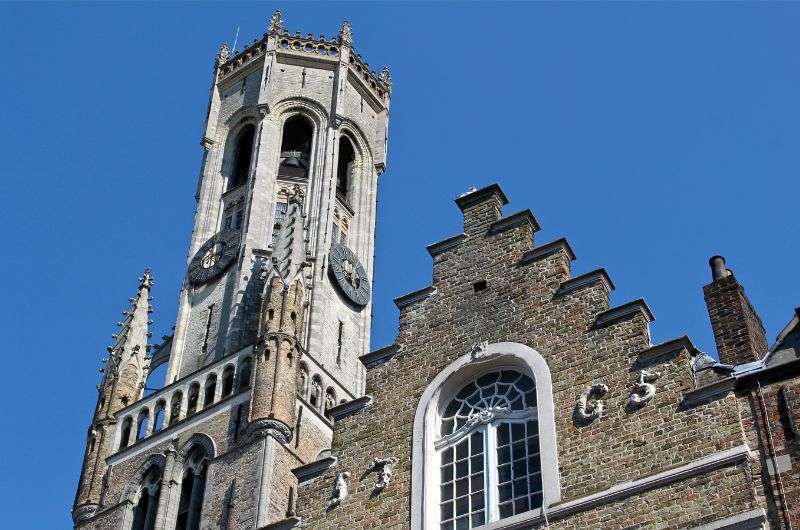
Bruges’ Belfry
Visiting bell towers is one of the top things to do in Belgium!
Seeing the museum exhibits and bells in the bell towers up close is always cool because they are a whole heck of a lot bigger than you’d think from way down on the ground, and you learn a ton about the city while you’re climbing up there.
The Bruges Belfry
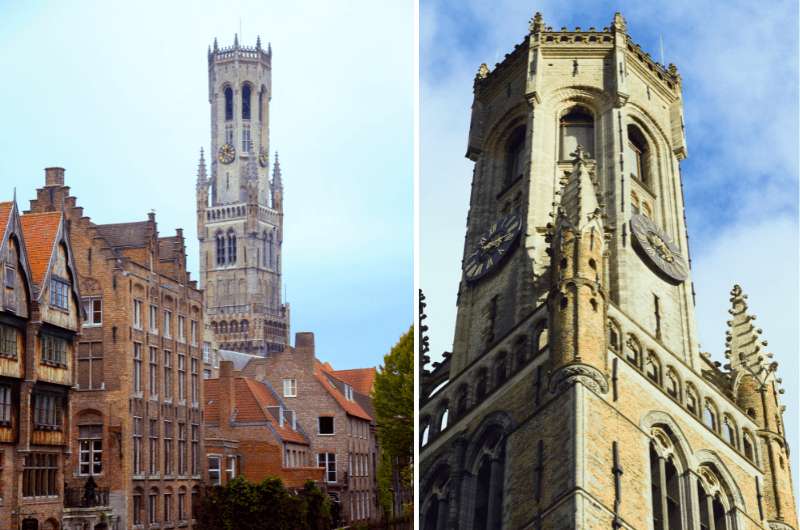
Bruges’ pretty bell tower
The Bruges Belfry might be known for being a tower with a view, but it also delivers a focused, well-presented museum experience, so I felt compelled to include it on my list of my favorite museums in Belgium, even if it’s a more unique type.
Along the way up the 366 stairs, you’ll pass exhibits on the building’s role in Bruges’ trade and politics, the history of the carillon, and the evolution of the tower itself. Make sure to take a good look at the massive drum mechanism that still controls the bells to this day.
The Belfry carillon has a total of 47 bells and you can hear them play on Wednesdays, Saturdays, and Sundays from 11 am–12 pm. And in the summer (June to September), they have an extra evening show on Mondays and Wednesdays around 8–9 pm.
This really is a must-visit place on any Bruges itinerary.
Get tickets in advance. Visitor numbers are limited, and tickets sell out frequently (I know because it happened to me and I was left outside).
Fun fact: To get the best view of the Belfry, go to the rooftop of the De Halve Maan Brewery (see item 6 on this list).
Visitor information
-
Belfry and carillon, Markt 7, Bruges
-
Open daily 9 am – 8 pm
-
Tickets cost €15 and need to be bought in advance. You get a time stamp and if you miss your time, you’re out of luck.
The Ghent Belfry
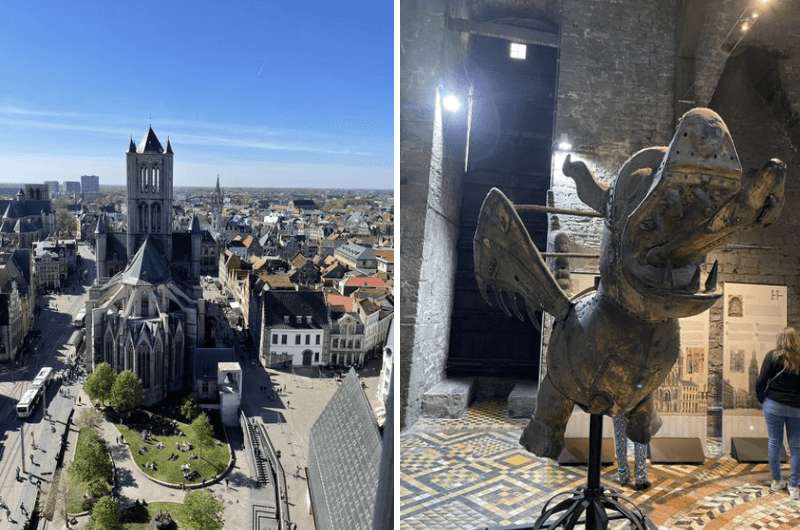
The view of St. Nicholas Church from the Belfry and the dragon statue inside
Ghent’s Belfry, a UNESCO Heritage Site, houses the mascot of Ghent, a dragon, and used to also hold the city’s alarm bell, nicknamed “Roland”. Since the bell cracked in 1914 it was taken down and is now on display next to St. Nicholas’ Church.
Now there are just the carillon bells that you can hear every Sunday before noon, and, during the summer, every Saturday night.
This isn’t a classic famous museum in Belgium, but I still think it needs to be on my list, because it still fits the bill. Inside, you’ll find the original dragon, displays on Ghent’s medieval defenses and bell-ringing tradition, and an interesting look at how the Belfry symbolized the city’s independence. It’s not huge, but what’s there is well done.
There are stairs up to the first floor and then you can take an elevator up to the tower.
Buy your tickets online in advance if you want to be sure to get inside.
Visitor information
-
Belfry tower, Sint-Baafsplein, Gent
-
Open daily 10 am–6 pm, in the summer 10am–8pm
-
Tickets cost €10 and can be bought in the ticket booth or online

How to plan a visit to the best museums in Belgium: notes before you go
-
Tickets in advance: Always check if you need to purchase your tickets in advance (I always mention if it’s necessary in my articles). The Belfry in Bruges is one of the places you need tickets beforehand. The Parlamentarium in Brussels doesn’t require actual tickets, but you still need to register online to be let in.
-
Leave your bags: Most museums in Belgium will have lockers at the entrance. You are not allowed to enter with backpacks or luggage or coats. They are usually free, but you’ll often need a €1 or €2 coin as a deposit.
-
Museum hours vary (and Monday is trouble): Many museums close on Mondays and some have weird midday breaks or short afternoon hours. Always check opening times before you show up
-
Get the Brussels Card: If you planning on visiting a few museums, check out the Brussels Card. It gives you free entry to 49 museums in Brussels. The price ranges from €39 for 24 hours to €57 for 72 hours.
-
Spend enough time at the museums in Brussels: Brussels full to the brim with incredible museums and it’s easy to underestimate the time you need to spend there on your itinerary. Here’s a 3-day trip plan for Brussels to help you out with your planning.
-
Choose your hotels wisely: I think basing yourself in Brussels is the best plan—Radisson Red has to be the coolest hotel in Belgium! If you’re not into day trips and want to stay the night in Ghent, I can vouch for Pillows Grand Boutique Hotel Reylof. In Bruges, there’s this classy place right on the canals: Relais Bourgondisch Cruyce.
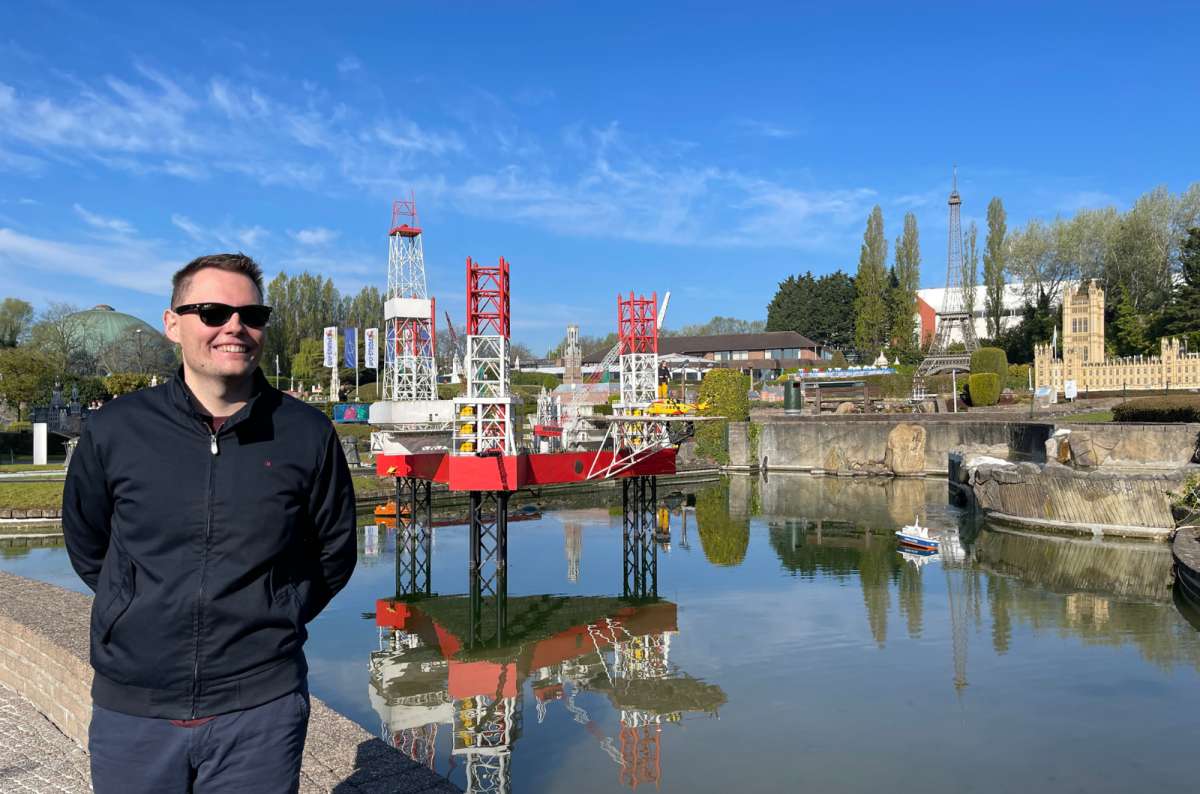
I still don’t get who could think that museums are boring @ Mini-Europe
You might also be interested in reading:
Sometimes, all you need to do is take the first step... I've filtered out the best hotels in Brussels for you
Save it for yourself to come back to later, or share with your friends on social media!
I've already planned your ititnerary for the trip, complete with my travel tips.
This post contains affiliate links. If you make a booking through one of my links, I may earn a small commission—at no additional cost to you. Thank you for your support!
Quick list: The best museums in Belgium with descriptions (ranked)
1. Bruges Beer Experience: A must-do museum in Belgium for EVERYONE
2. Mini-Europe in Brusselss: the “tiniest” fun museum in Belgium
3. Parlamentarium in Brussels: a museum that’ll spark your love for the EU
4. Autoworld in Brussels: the biggest car museum I’ve ever seen
6. De Halve Maan Brewery in Bruges: check out the unique beer pipline!
7. Train World In Brussels: step inside an original Orient Express car!
8. Choco Story Museum in Brussels: is it better than the one in Bruges?
9. The House of European History in Brussels: A museum inside the European Partliament
10. Photography Museum in Charleroi: the best photography museum in Europe
11. Comics Art Museum in Brussels: A kid-friendly museum in Brussels that’s also fun for adults
12. The Atomium in Brussels: go inside one of Europe’s most famous modern structures
13. Bruges Art Museums: The quieter side of Belgian art, with more history than crowds
14. Musée Magritte Museum in Brussels: the best place to get “surreal” with Belgian art
15. The Belfries in Bruges and Ghent: two iconic towers with museums inside
How to plan a visit to the best museums in Belgium: notes before you go




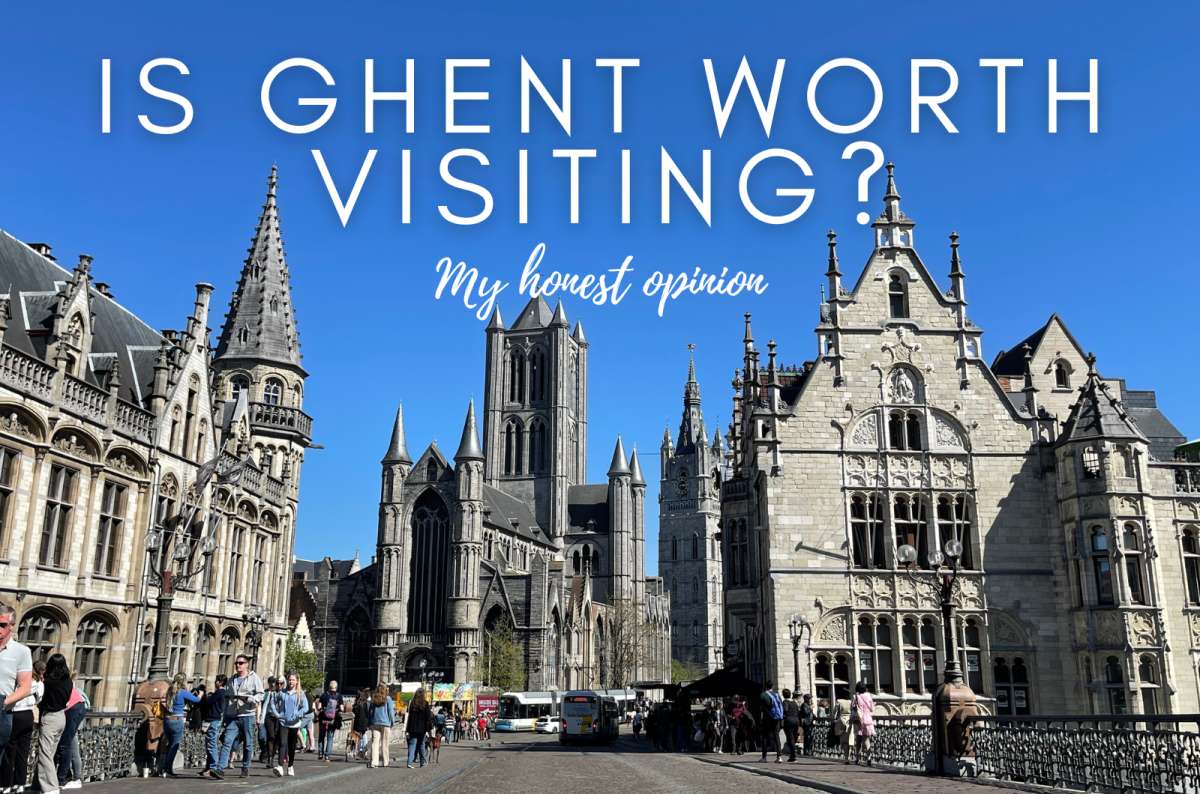

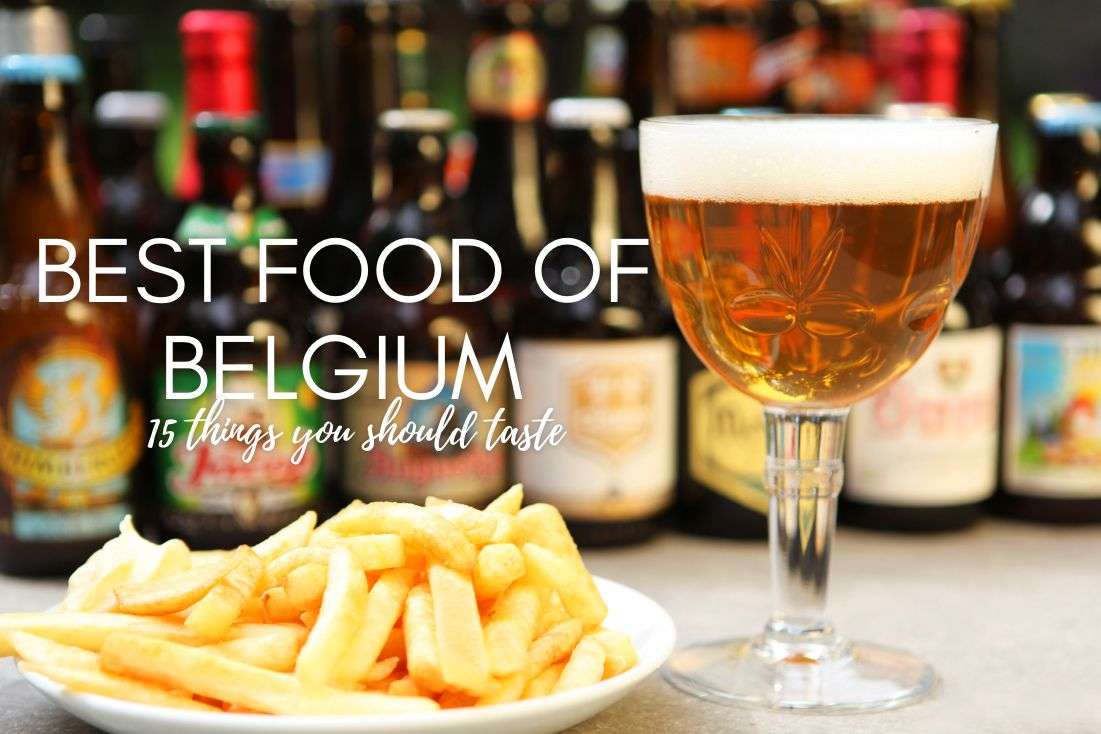



Comments | Thoughts? Give us a shout!